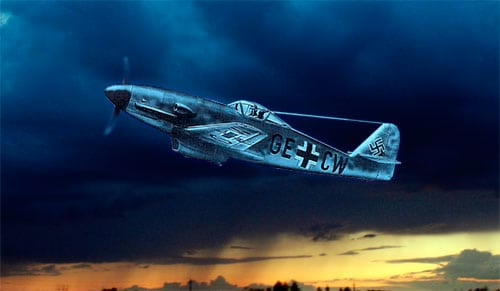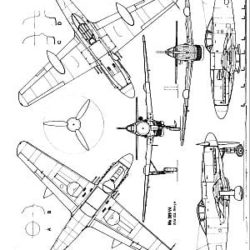Messerschmitt Me 309 History
The Messerschmitt Me 309 was an experimental single-seat fighter with Daimler-Benz DB 603 of Junkers Jumor 213 liquid-cooled engine and tricycle landing-gear. It was superficially similar in appearance to the American Bell P-39 Airacobra, but, although considerably more advanced than this aircraft, the Me 309 was never to enjoy the same success.
It was an all-metal single-seat low-wing monoplane although the wing was not quite flush with the bottom of the fuselage. The wing had a tapered platform with rounded tips and considerable dihedral and was fitted with automatic leading-edge slots and large plain flaps which extended from the wing roots to the inboard ends of the ailerons.
The tailplane was attached at the base of the fin, both elevators and rudder being dynamically balanced. The fuselage, with its oval cross-section, carried the fuel and had the cockpit set well back in line with the trailing edge of the wing. A raised cockpit canopy gave all-round vision and had a hinged centre section for access. The large, retractable, ventral radiator was situated beneath the fuselage in line with the wing and the engine air intake was positioned on the port side of the nose cowling. The main undercarriage units retracted inwards into the wing and the nosewheel rearwards into the fuselage, the nosewheel and part of its leg turning through 90 deg to lie flat beneath the engine.
On 27 June, 1942 the Messerschmitt Me 309 V1 (GE-CU) began taxi-ing trials, which revealed a disconcerting tendency towards nosewheel shimmy and directional instability, while in flight snaking at high speeds indicated the need for redesign of the vertical tail surfaces. After some modifications, including improvement of the cooling system, the V1 made a short first flight on 18 July, 1942, but the undercarriage hydraulic-retraction system proved too weak, and engine overheating occurred. Further flights revealed more shortcomings including instability, and a succession of modifications were made in an effort to improve the aircraft. These included alterations to the tailplane, ailerons, nosewheel leg and undercarriage hydraulic syste; but the aircraft was still unsatisfactory and Messeschmitt’s chief test pilot, Fritz Wendel, had formed the opinion that the type offered few advantages over the Bf 109 and would be difficult for Service pilots to handle, primary because of the high wing loading.
On 28 November, 1942, the Messerschmitt Me 309 V2 (GE-CV) made its first and last flight, since its nosewheel leg collapsed on landing and the aircraft swerved on its nose and broke almost in two. By mid-1943, the Messerschmitt Me 309 was regarded as little more than an experimental flying test-bed, and its actual development as a fighter had been abandoned in view of its shortcomings in this direction and the greater promise of Messerschmitt’s Me 262 turbojet fighter.









